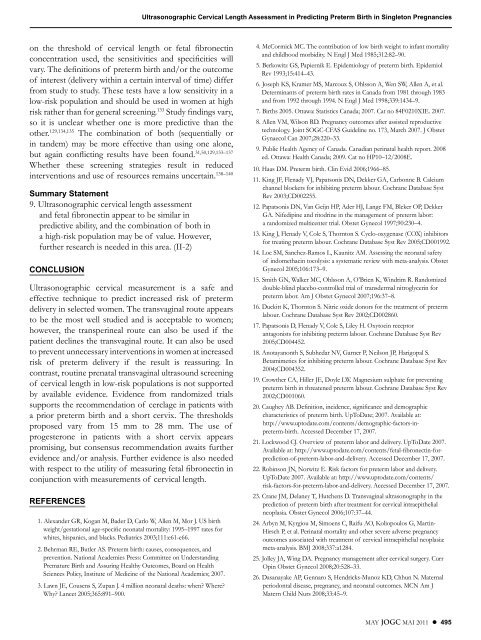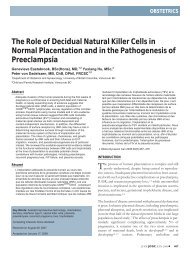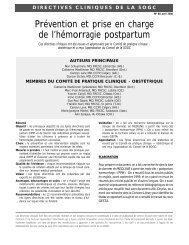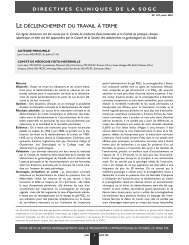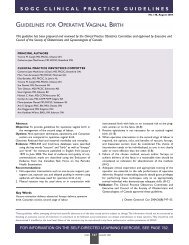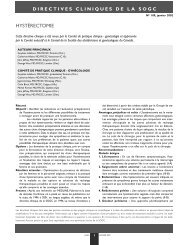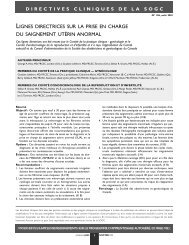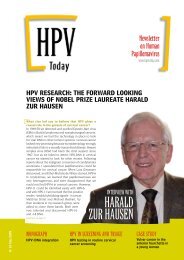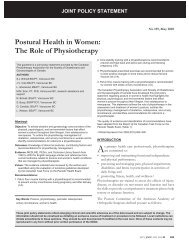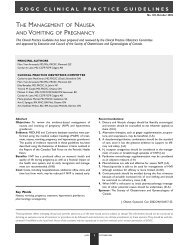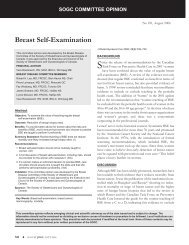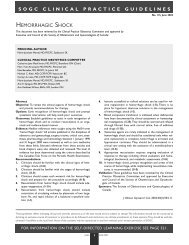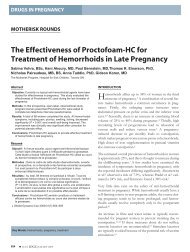Ultrasonographic Cervical Length Assessment in Predicting ... - SOGC
Ultrasonographic Cervical Length Assessment in Predicting ... - SOGC
Ultrasonographic Cervical Length Assessment in Predicting ... - SOGC
Create successful ePaper yourself
Turn your PDF publications into a flip-book with our unique Google optimized e-Paper software.
on the threshold of cervical length or fetal fibronect<strong>in</strong><br />
concentration used, the sensitivities and specificities will<br />
vary. The def<strong>in</strong>itions of preterm birth and/or the outcome<br />
of <strong>in</strong>terest (delivery with<strong>in</strong> a certa<strong>in</strong> <strong>in</strong>terval of time) differ<br />
from study to study. These tests have a low sensitivity <strong>in</strong> a<br />
low-risk population and should be used <strong>in</strong> women at high<br />
risk rather than for general screen<strong>in</strong>g. 133 Study f<strong>in</strong>d<strong>in</strong>gs vary,<br />
so it is unclear whether one is more predictive than the<br />
other. 129,134,135 The comb<strong>in</strong>ation of both (sequentially or<br />
<strong>in</strong> tandem) may be more effective than us<strong>in</strong>g one alone,<br />
but aga<strong>in</strong> conflict<strong>in</strong>g results have been found. 31,50,129,133–137<br />
Whether these screen<strong>in</strong>g strategies result <strong>in</strong> reduced<br />
<strong>in</strong>terventions and use of resources rema<strong>in</strong>s uncerta<strong>in</strong>. 138–140<br />
Summary Statement<br />
9. <strong>Ultrasonographic</strong> cervical length assessment<br />
and fetal fibronect<strong>in</strong> appear to be similar <strong>in</strong><br />
predictive ability, and the comb<strong>in</strong>ation of both <strong>in</strong><br />
a high-risk population may be of value. However,<br />
further research is needed <strong>in</strong> this area. (II-2)<br />
CONCLUSION<br />
<strong>Ultrasonographic</strong> cervical measurement is a safe and<br />
effective technique to predict <strong>in</strong>creased risk of preterm<br />
delivery <strong>in</strong> selected women. The transvag<strong>in</strong>al route appears<br />
to be the most well studied and is acceptable to women;<br />
however, the transper<strong>in</strong>eal route can also be used if the<br />
patient decl<strong>in</strong>es the transvag<strong>in</strong>al route. It can also be used<br />
to prevent unnecessary <strong>in</strong>terventions <strong>in</strong> women at <strong>in</strong>creased<br />
risk of preterm delivery if the result is reassur<strong>in</strong>g. In<br />
contrast, rout<strong>in</strong>e prenatal transvag<strong>in</strong>al ultrasound screen<strong>in</strong>g<br />
of cervical length <strong>in</strong> low-risk populations is not supported<br />
by available evidence. Evidence from randomized trials<br />
supports the recommendation of cerclage <strong>in</strong> patients with<br />
a prior preterm birth and a short cervix. The thresholds<br />
proposed vary from 15 mm to 28 mm. The use of<br />
progesterone <strong>in</strong> patients with a short cervix appears<br />
promis<strong>in</strong>g, but consensus recommendation awaits further<br />
evidence and/or analysis. Further evidence is also needed<br />
with respect to the utility of measur<strong>in</strong>g fetal fibronect<strong>in</strong> <strong>in</strong><br />
conjunction with measurements of cervical length.<br />
REFERENCES<br />
1. Alexander GR, Kogan M, Bader D, Carlo W, Allen M, Mor J. US birth<br />
weight/gestational age-specific neonatal mortality: 1995–1997 rates for<br />
whites, hispanics, and blacks. Pediatrics 2003;111:e61-e66.<br />
2. Behrman RE, Butler AS. Preterm birth: causes, consequences, and<br />
prevention. National Academies Press: Committee on Understand<strong>in</strong>g<br />
Premature Birth and Assur<strong>in</strong>g Healthy Outcomes, Board on Health<br />
Sciences Policy, Institute of Medic<strong>in</strong>e of the National Academies; 2007.<br />
3. Lawn JE, Cousens S, Zupan J. 4 million neonatal deaths: when? Where?<br />
Why? Lancet 2005;365:891–900.<br />
<strong>Ultrasonographic</strong> <strong>Cervical</strong> <strong>Length</strong> <strong>Assessment</strong> <strong>in</strong> Predict<strong>in</strong>g Preterm Birth <strong>in</strong> S<strong>in</strong>gleton Pregnancies<br />
4. McCormick MC. The contribution of low birth weight to <strong>in</strong>fant mortality<br />
and childhood morbidity. N Engl J Med 1985;312:82–90.<br />
5. Berkowitz GS, Papiernik E. Epidemiology of preterm birth. Epidemiol<br />
Rev 1993;15:414–43.<br />
6. Joseph KS, Kramer MS, Marcoux S, Ohlsson A, Wen SW, Allen A, et al.<br />
Determ<strong>in</strong>ants of preterm birth rates <strong>in</strong> Canada from 1981 through 1983<br />
and from 1992 through 1994. N Engl J Med 1998;339:1434–9.<br />
7. Births 2005. Ottawa: Statistics Canada; 2007. Cat no 84F0210XIE. 2007.<br />
8. Allen VM, Wilson RD. Pregnancy outcomes after assisted reproductive<br />
technology. Jo<strong>in</strong>t <strong>SOGC</strong>-CFAS Guidel<strong>in</strong>e no. 173, March 2007. J Obstet<br />
Gynaecol Can 2007;28:220–33.<br />
9. Public Health Agency of Canada. Canadian per<strong>in</strong>atal health report. 2008<br />
ed. Ottawa: Health Canada; 2009. Cat no HP10–12/2008E.<br />
10. Haas DM. Preterm birth. Cl<strong>in</strong> Evid 2006;1966–85.<br />
11. K<strong>in</strong>g JF, Flenady VJ, Papatsonis DN, Dekker GA, Carbonne B. Calcium<br />
channel blockers for <strong>in</strong>hibit<strong>in</strong>g preterm labour. Cochrane Database Syst<br />
Rev 2003;CD002255.<br />
12. Papatsonis DN, Van Geijn HP, Ader HJ, Lange FM, Bleker OP, Dekker<br />
GA. Nifedip<strong>in</strong>e and ritodr<strong>in</strong>e <strong>in</strong> the management of preterm labor:<br />
a randomized multicenter trial. Obstet Gynecol 1997;90:230–4.<br />
13. K<strong>in</strong>g J, Flenady V, Cole S, Thornton S. Cyclo-oxygenase (COX) <strong>in</strong>hibitors<br />
for treat<strong>in</strong>g preterm labour. Cochrane Database Syst Rev 2005;CD001992.<br />
14. Loe SM, Sanchez-Ramos L, Kaunitz AM. Assess<strong>in</strong>g the neonatal safety<br />
of <strong>in</strong>domethac<strong>in</strong> tocolysis: a systematic review with meta-analysis. Obstet<br />
Gynecol 2005;106:173–9.<br />
15. Smith GN, Walker MC, Ohlsson A, O’Brien K, W<strong>in</strong>drim R. Randomized<br />
double-bl<strong>in</strong>d placebo-controlled trial of transdermal nitroglycer<strong>in</strong> for<br />
preterm labor. Am J Obstet Gynecol 2007;196:37–8.<br />
16. Duckitt K, Thornton S. Nitric oxide donors for the treatment of preterm<br />
labour. Cochrane Database Syst Rev 2002;CD002860.<br />
17. Papatsonis D, Flenady V, Cole S, Liley H. Oxytoc<strong>in</strong> receptor<br />
antagonists for <strong>in</strong>hibit<strong>in</strong>g preterm labour. Cochrane Database Syst Rev<br />
2005;CD004452.<br />
18. Anotayanonth S, Subhedar NV, Garner P, Neilson JP, Harigopal S.<br />
Betamimetics for <strong>in</strong>hibit<strong>in</strong>g preterm labour. Cochrane Database Syst Rev<br />
2004;CD004352.<br />
19. Crowther CA, Hiller JE, Doyle LW. Magnesium sulphate for prevent<strong>in</strong>g<br />
preterm birth <strong>in</strong> threatened preterm labour. Cochrane Database Syst Rev<br />
2002;CD001060.<br />
20. Caughey AB. Def<strong>in</strong>ition, <strong>in</strong>cidence, significance and demographic<br />
characteristics of preterm birth. UpToDate; 2007. Available at:<br />
http://www.uptodate.com/contents/demographic-factors-<strong>in</strong>preterm-birth.<br />
Accessed December 17, 2007.<br />
21. Lockwood CJ. Overview of preterm labor and delivery. UpToDate 2007.<br />
Available at: http://www.uptodate.com/contents/fetal-fibronect<strong>in</strong>-forprediction-of-preterm-labor-and-delivery.<br />
Accessed December 17, 2007.<br />
22. Rob<strong>in</strong>son JN, Norwitz E. Risk factors for preterm labor and delivery.<br />
UpToDate 2007. Available at: http://www.uptodate.com/contents/<br />
risk-factors-for-preterm-labor-and-delivery. Accessed December 17, 2007.<br />
23. Crane JM, Delaney T, Hutchens D. Transvag<strong>in</strong>al ultrasonography <strong>in</strong> the<br />
prediction of preterm birth after treatment for cervical <strong>in</strong>traepithelial<br />
neoplasia. Obstet Gynecol 2006;107:37–44.<br />
24. Arbyn M, Kyrgiou M, Simoens C, Raifu AO, Koliopoulos G, Mart<strong>in</strong>-<br />
Hirsch P, et al. Per<strong>in</strong>atal mortality and other severe adverse pregnancy<br />
outcomes associated with treatment of cervical <strong>in</strong>traepithelial neoplasia:<br />
meta-analysis. BMJ 2008;337:a1284.<br />
25. Jolley JA, W<strong>in</strong>g DA. Pregnancy management after cervical surgery. Curr<br />
Op<strong>in</strong> Obstet Gynecol 2008;20:528–33.<br />
26. Dasanayake AP, Gennaro S, Hendricks-Munoz KD, Chhun N. Maternal<br />
periodontal disease, pregnancy, and neonatal outcomes. MCN Am J<br />
Matern Child Nurs 2008;33:45–9.<br />
MAY JOGC MAI 2011 l 495


